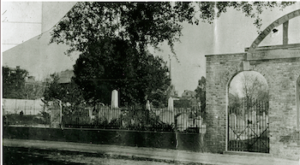
The Brown Fellowship Society cemetery
*The Brown Fellowship Society, a Black self-help organization, was founded on this date in 1790.
They were founded in Charleston, South Carolina, and their motto was "Charity and Benevolence." They were founded by five free nonwhites who attended St. Philip's Episcopal Church: James Mitchell, George Bampfield, William Cattel, George Bedon, and Samuel Saltus. They were founded "to provide benefits the white church denied them, like a proper burial ground, widow and orphan care, and assistance in times of sickness."
The group's cemetery was an essential part of its function. Those who joined the club considered themselves "brown" mulattoes, an important distinction when Charleston society recognized three races: White, Mulatto, and Negro, including octoroons and quadroons. Unlike some mutual self-help organizations in the African American community, the Brown Society was not linked to any church, and it even banned the discussion of religion. Many Brown Fellowship Society members had businesses, and some were prosperous.
In 1843, the free black man Thomas Smalls applied for membership in the Brown Fellowship Society and was turned down because he was too black (dark). He set up his society, The Society for Free Blacks of Dark Complexion (later renamed the Brotherly Society). He opened a graveyard for pure African descent, the MacPhelah cemetery adjacent to the Brown Fellowship Graveyard, and another one, Ephrath (still intact today). The Brown Fellowship Society did not intervene in the status of enslaved people at the time.
The organization created a cemetery for "brown" black people. Society could buy grounds for a cemetery and a meeting house. The society had merely 50 members. Each had to pay a $50 membership fee and went through three different votes before being admitted. The organization forbids talks about political or religious matters. The organization cared for widows, provided a primary school, supported its members' businesses, and lobbied for white society. "After the American Civil War, the Brown Fellowship Society expanded to include more African Americans, including women and those of darker skin."
In 1892, The Society became the Century Fellowship Society. In 1943, Charleston passed an ordinance prohibiting private organizations from maintaining graveyards. The Century Fellowship Society sold the original BFS cemetery in 1945 to Bishop England High School, officially dissolving the society. For many years afterward, the Catholic Diocese kept affirming that the cemetery had been cleared of corpses. Still, in 2001, four gravesites were discovered when the College of Charleston's Addlestone Library was constructed. The whole cemetery was paved over. Society records are held at the Avery Research Center for African American History and Culture.